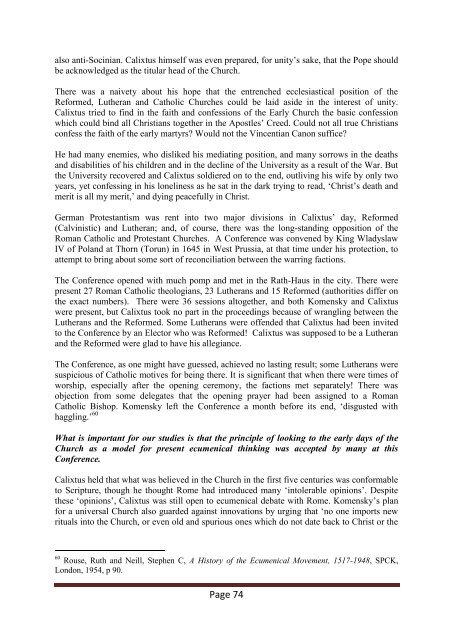Digging Out the Embedded Church - The Maranatha Community
Digging Out the Embedded Church - The Maranatha Community
Digging Out the Embedded Church - The Maranatha Community
You also want an ePaper? Increase the reach of your titles
YUMPU automatically turns print PDFs into web optimized ePapers that Google loves.
also anti-Socinian. Calixtus himself was even prepared, for unity‟s sake, that <strong>the</strong> Pope should<br />
be acknowledged as <strong>the</strong> titular head of <strong>the</strong> <strong>Church</strong>.<br />
<strong>The</strong>re was a naivety about his hope that <strong>the</strong> entrenched ecclesiastical position of <strong>the</strong><br />
Reformed, Lu<strong>the</strong>ran and Catholic <strong>Church</strong>es could be laid aside in <strong>the</strong> interest of unity.<br />
Calixtus tried to find in <strong>the</strong> faith and confessions of <strong>the</strong> Early <strong>Church</strong> <strong>the</strong> basic confession<br />
which could bind all Christians toge<strong>the</strong>r in <strong>the</strong> Apostles‟ Creed. Could not all true Christians<br />
confess <strong>the</strong> faith of <strong>the</strong> early martyrs? Would not <strong>the</strong> Vincentian Canon suffice?<br />
He had many enemies, who disliked his mediating position, and many sorrows in <strong>the</strong> deaths<br />
and disabilities of his children and in <strong>the</strong> decline of <strong>the</strong> University as a result of <strong>the</strong> War. But<br />
<strong>the</strong> University recovered and Calixtus soldiered on to <strong>the</strong> end, outliving his wife by only two<br />
years, yet confessing in his loneliness as he sat in <strong>the</strong> dark trying to read, „Christ‟s death and<br />
merit is all my merit,‟ and dying peacefully in Christ.<br />
German Protestantism was rent into two major divisions in Calixtus‟ day, Reformed<br />
(Calvinistic) and Lu<strong>the</strong>ran; and, of course, <strong>the</strong>re was <strong>the</strong> long-standing opposition of <strong>the</strong><br />
Roman Catholic and Protestant <strong>Church</strong>es. A Conference was convened by King Wladyslaw<br />
IV of Poland at Thorn (Torun) in 1645 in West Prussia, at that time under his protection, to<br />
attempt to bring about some sort of reconciliation between <strong>the</strong> warring factions.<br />
<strong>The</strong> Conference opened with much pomp and met in <strong>the</strong> Rath-Haus in <strong>the</strong> city. <strong>The</strong>re were<br />
present 27 Roman Catholic <strong>the</strong>ologians, 23 Lu<strong>the</strong>rans and 15 Reformed (authorities differ on<br />
<strong>the</strong> exact numbers). <strong>The</strong>re were 36 sessions altoge<strong>the</strong>r, and both Komensky and Calixtus<br />
were present, but Calixtus took no part in <strong>the</strong> proceedings because of wrangling between <strong>the</strong><br />
Lu<strong>the</strong>rans and <strong>the</strong> Reformed. Some Lu<strong>the</strong>rans were offended that Calixtus had been invited<br />
to <strong>the</strong> Conference by an Elector who was Reformed! Calixtus was supposed to be a Lu<strong>the</strong>ran<br />
and <strong>the</strong> Reformed were glad to have his allegiance.<br />
<strong>The</strong> Conference, as one might have guessed, achieved no lasting result; some Lu<strong>the</strong>rans were<br />
suspicious of Catholic motives for being <strong>the</strong>re. It is significant that when <strong>the</strong>re were times of<br />
worship, especially after <strong>the</strong> opening ceremony, <strong>the</strong> factions met separately! <strong>The</strong>re was<br />
objection from some delegates that <strong>the</strong> opening prayer had been assigned to a Roman<br />
Catholic Bishop. Komensky left <strong>the</strong> Conference a month before its end, „disgusted with<br />
haggling.‟ 60<br />
What is important for our studies is that <strong>the</strong> principle of looking to <strong>the</strong> early days of <strong>the</strong><br />
<strong>Church</strong> as a model for present ecumenical thinking was accepted by many at this<br />
Conference.<br />
Calixtus held that what was believed in <strong>the</strong> <strong>Church</strong> in <strong>the</strong> first five centuries was conformable<br />
to Scripture, though he thought Rome had introduced many „intolerable opinions‟. Despite<br />
<strong>the</strong>se „opinions‟, Calixtus was still open to ecumenical debate with Rome. Komensky‟s plan<br />
for a universal <strong>Church</strong> also guarded against innovations by urging that „no one imports new<br />
rituals into <strong>the</strong> <strong>Church</strong>, or even old and spurious ones which do not date back to Christ or <strong>the</strong><br />
60 Rouse, Ruth and Neill, Stephen C, A History of <strong>the</strong> Ecumenical Movement, 1517-1948, SPCK,<br />
London, 1954, p 90.<br />
Page 74








